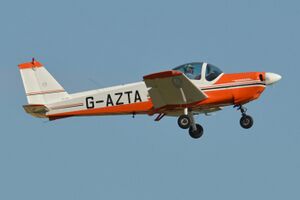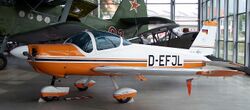Engineering:MBB Bo 209 Monsun
| Bo 209 Monsun | |
|---|---|

| |
| Role | Civil utility aircraft |
| National origin | West Germany |
| Manufacturer | Bölkow MBB |
| First flight | 22 December 1967 (MHK-101) |
| Number built | 2 MHK-101 and 102 Bo 209 |
| Developed into | Mylius My-103 Mistral |
The MBB Bo 209 Monsun (originally the Bolkow MHK-101) is a two-seat light aircraft that was developed in West Germany in the late 1960s.
Design and development
The Monsun was designed by three Bölkow engineers, led by Bölkow's technical director Dr Hermann Mylius, in their spare time with the intention of creating a more versatile aircraft than the Bölkow Bo 208, with design work beginning in 1965. The new aircraft, designated the MHK-101, was a low-wing monoplane of all-metal construction with a tricycle undercarriage, which had fixed mainwheels, with the option for the nosewheel to be fixed or retractable. While the MHK-101 used some components of the Bo-208, it had a larger and more comfortable cockpit, and an entirely new wing, which could be folded for towing and storage (the Bo 208 was a high-wing aircraft).[1][2]
The first prototype MHK-101, powered by a 125 hp (93 kW) Lycoming O-235 engine driving a fixed-pitch propeller and with a retractable nosewheel, flew on 22 December 1967.[3][4] In April 1969, Bölkow selected the MK-101 to replace the Bo 208 in production, with the type becoming the "Bölkow Bo 209 Monson".[1] A second prototype flew in May 1969.[5] That year, Messerschmitt-Bölkow merged with Messerschmitt-Bölkow to become Messerschmitt-Bölkow-Blohm, with the aircraft becoming the MBB Bo 209.[6] The aircraft, which was offered with a variety of engines, a choice of fixed or variable pitch propellers and fixed or retractable nosewheels, entered production at MBB's Laupheim factory early in 1970 and received its type certificate on 9 April 1970.[3]
With this broad array of equipment options Bölkow displayed the aircraft at the Air Show in Hanover 1970: 57 orders of the new type were drawn in advance and commercial success of the project seemed secured.[citation needed] In March 1972, however, MBB stopped production of the Bo 209 in order to concentrate on the MBB Bo 105 helicopter.[7], after production of 100 Bo 209s in addition to the two prototypes.[8][9] Rights to the Bo 208 were purchased by Pneuma-Technik E. Ficht who planned to build the Monsun at Weiden, Bavaria, setting up Monson Gmbh in November 1973, but only two aircraft were built before production ended in June 1974.[10] A United States businessman invested in the model, secured funding, and started shipping factory equipment to Georgia. Before completion of the transition, the investor committed suicide after losses in stock market speculation.[11]
In the late 1990s Dr. Mylius's son, Albert Mylius, completed a totally revised version of his father's design under a new company, Mylius Flugzeugwerk GmbH & Co KG, based in Bitburg. Two models were produced: a single seat developed as a low cost aerobatic airplane (My-102), and the two-seat Mylius My-103 Mistral, which has some variations over the original Bo 209 design, like wider cockpit, better handling characteristics and improved overall performance (including aerobatic rating) with a more powerful 200 hp engine.
Variants
- MHK-101 prototype[4]
- Bo 209-125 - proposed production version with 125 hp (93 kW) Lycoming O-235 engine.[5] No production.[8][9]
- Bo 209-150 - production version with 150 hp (110 kW) Lycoming O-320-E1C engine.[5][6]
- Bo 209-160 - production version with 160 hp (120 kW) Lycoming IO-320-D1A engine.[5][6]
- Bo 209S - trainer version with dual controls, non-retracting nosewheel, and non-folding wings, powered by 130 hp (97 kW) Rolls-Royce Continental O-240-A.[5][6]
Specifications (Bo 209-160)
Data from Jane's All The World's Aircraft 1971-72[12]
General characteristics
- Crew: 1
- Capacity: 1 passenger
- Length: 6.60 m (21 ft 8 in)
- Wingspan: 8.40 m (27 ft 7 in)
- Height: 2.20 m (7 ft 3 in)
- Wing area: 10.22 m2 (110.0 sq ft)
- Aspect ratio: 6.8:1
- Airfoil: NACA 64215 at root, NACA 64212 at tip
- Empty weight: 484 kg (1,067 lb)
- Max takeoff weight: 820 kg (1,808 lb)
- Fuel capacity: 140 L (37 US gal; 31 imp gal)
- Powerplant: 1 × Lycoming O-320-D1A air-cooled flat-four engine, 120 kW (160 hp)
Performance
- Maximum speed: 274 km/h (170 mph, 148 kn) at sea level
- Cruise speed: 243 km/h (151 mph, 131 kn) at 2,400 metres (8,000 ft) (econ. cruise, 65% power)
- Stall speed: 100 km/h (62 mph, 54 kn) (flaps down)
- Never exceed speed: 320 km/h (200 mph, 170 kn)
- Range: 1,200 km (750 mi, 650 nmi) (65% power, no reserves)
- Endurance: 5 hr 14 min
- Service ceiling: 5,520 m (18,110 ft)
- Rate of climb: 6.0 m/s (1,180 ft/min)
- Time to altitude: 2 min 48 sec to 1,000 m (3,300 ft)
See also
Related development
Aircraft of comparable role, configuration and era
- Piper PA-38 Tomahawk
- Beechcraft 77 Skipper
Notes
- ↑ 1.0 1.1 Archive 1991 No. 2, p. 46.
- ↑ Taylor 1968, pp. 80–81.
- ↑ 3.0 3.1 Archive 1991 No. 2, pp. 46–47.
- ↑ 4.0 4.1 Taylor 1968, p. 81.
- ↑ 5.0 5.1 5.2 5.3 5.4 Archive 1991 No. 2, p. 47.
- ↑ 6.0 6.1 6.2 6.3 Taylor 1971, p. 88.
- ↑ Archive 1991 No. 3, pp. 75–76.
- ↑ 8.0 8.1 Archive 1991 No. 2, pp. 47–48.
- ↑ 9.0 9.1 Archive 1991 No. 3, pp. 73–75.
- ↑ Archive 1991 No. 3, p. 76.
- ↑ Weiman 1979, p. 43.
- ↑ Taylor 1971, pp. 88–89.
References
- "Aircraft of European Civil Registers : 6: The Bölkow Lightplanes: Part Six". Archive (Air-Britain) (2): 45–48. 1991. ISSN 0262-4923.
- "Aircraft of European Civil Registers : 6: The Bölkow Lightplanes: Part Seven". Archive (Air-Britain) (3): 73–76. 1991. ISSN 0262-4923.
- Taylor, John W. R., ed (1968). Jane's All The World's Aircraft 1968-69. London: Sampson Low, Marston & Company, Ltd..
- Taylor, John W. R., ed (1971). Jane's All The World's Aircraft 1971-72. London: Jane's Yearbooks. ISBN 0-354-00094-2.
- Taylor, Michael J. H. (1989). Jane's Encyclopedia of Aviation. London: Studio Editions. pp. 192.
- Simpson, R. W. (1995). Airlife's General Aviation. Shrewsbury: Airlife Publishing. pp. 85.
- Weiman, Dave (January 1979). "The Messerschmitt that was supposed to be made in the U.S.". Air Progress: 40–43, 82–83. https://archive.org/details/sim_air-progress_1979-01_41_1/page/40/mode/2up. Retrieved 10 January 2022.
 |


